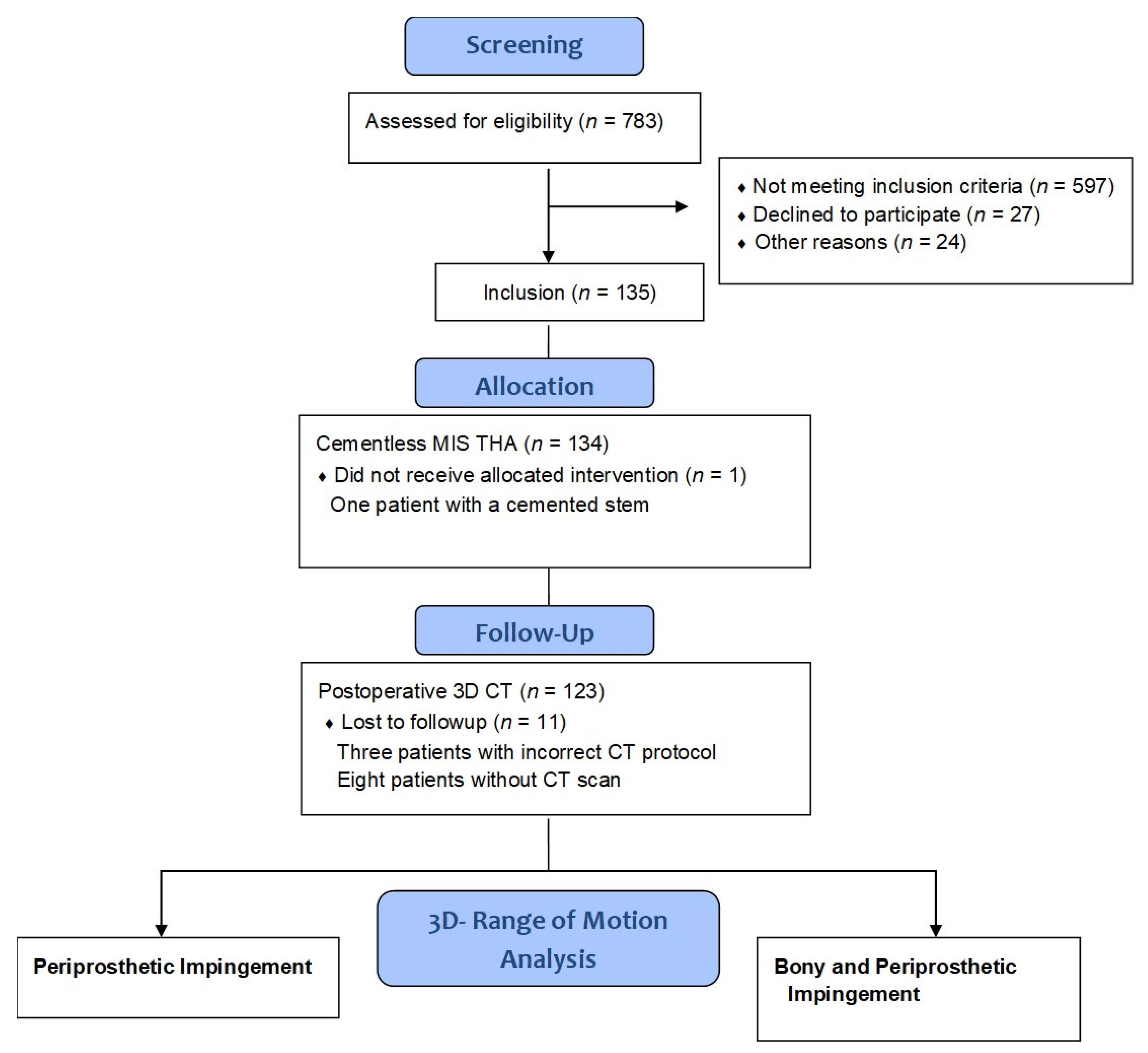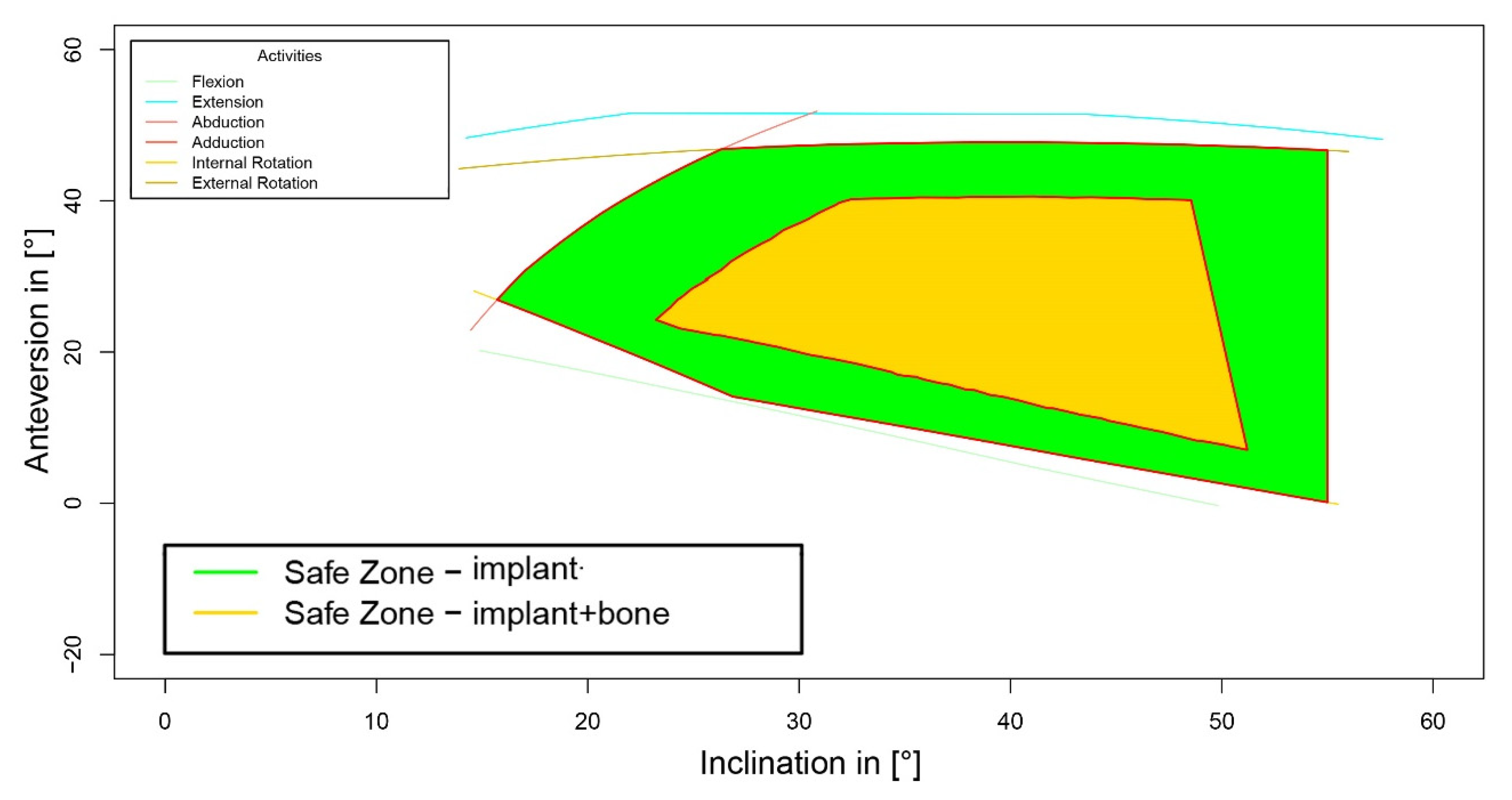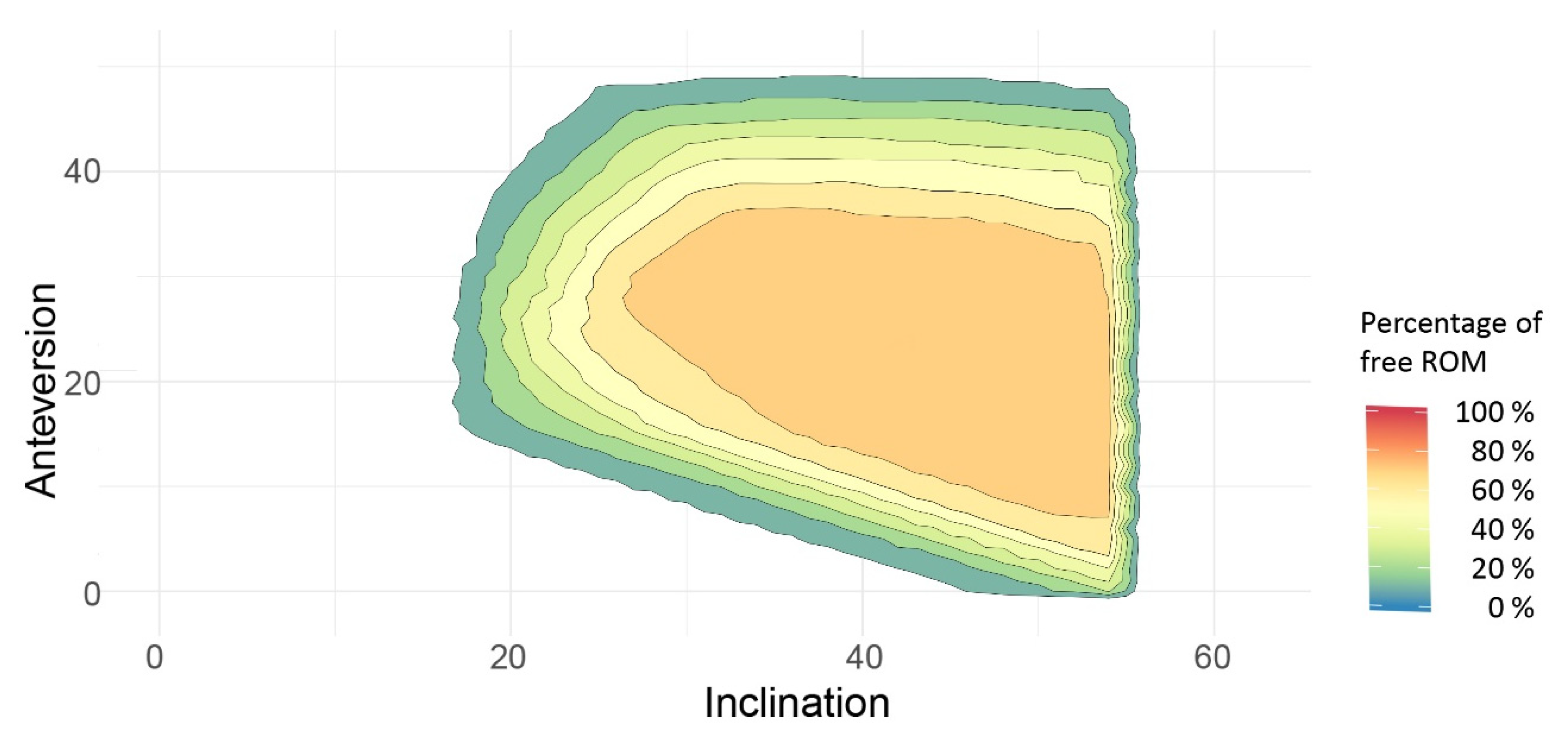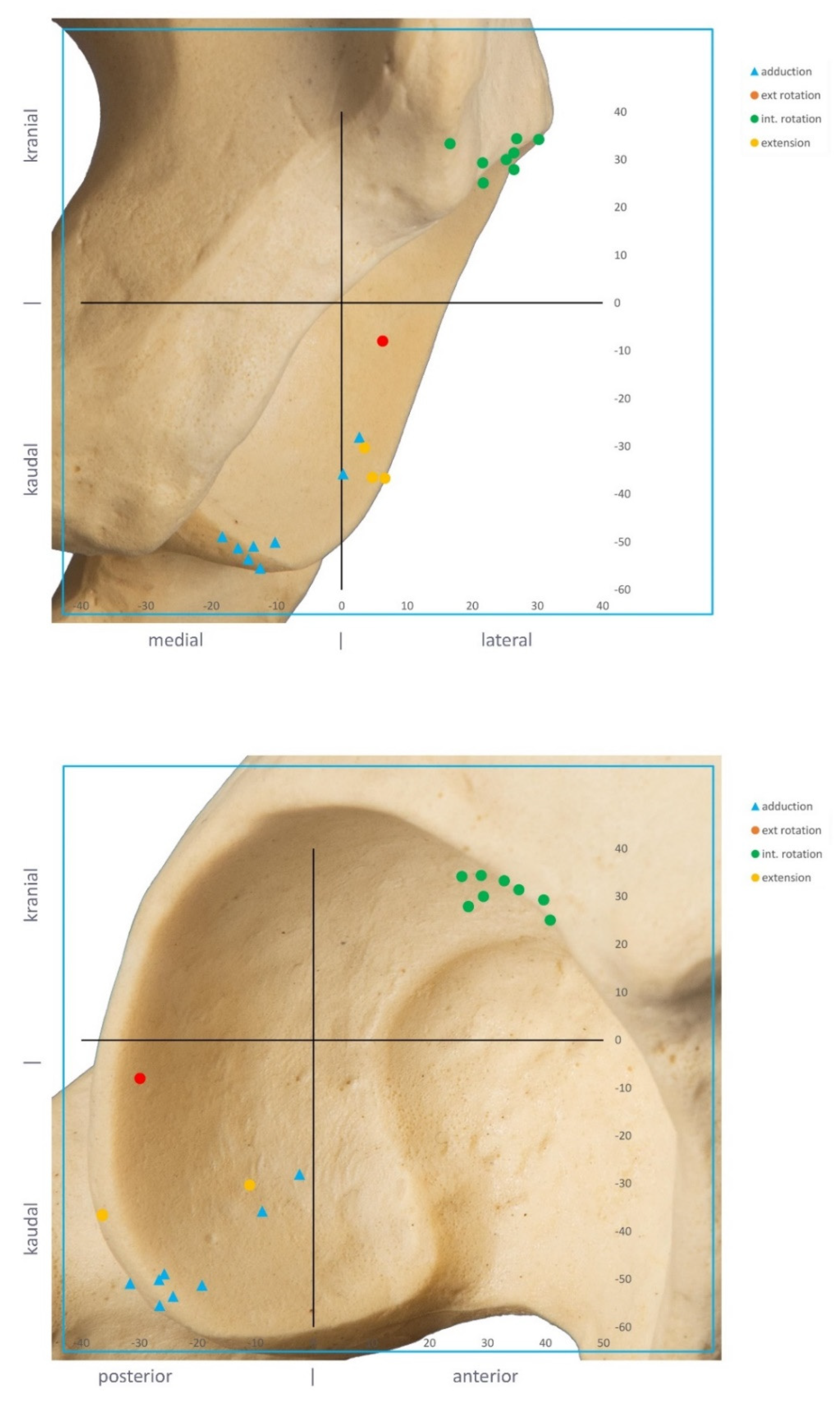Which Safe Zone Is Safe in Total Hip Arthroplasty? The Effect of Bony Impingement
Abstract
1. Introduction
2. Patients and Methods
3. Results
4. Discussion
Author Contributions
Funding
Institutional Review Board Statement
Informed Consent Statement
Data Availability Statement
Acknowledgments
Conflicts of Interest
References
- Weber, M.; Craiovan, B.; Woerner, M.L.; Schwarz, T.; Grifka, J.; Renkawitz, T.F. Predictors of Outcome After Primary Total Joint Replacement. J. Arthroplast. 2018, 33, 431–435. [Google Scholar] [CrossRef] [PubMed]
- Shon, W.Y.; Baldini, T.; Peterson, M.G.; Wright, T.M.; Salvati, E.A. Impingement in total hip arthroplasty a study of retrieved acetabular components. J. Arthroplast. 2005, 20, 427–435. [Google Scholar] [CrossRef] [PubMed]
- Bozic, K.J.; Kurtz, S.M.; Lau, E.; Ong, K.; Vail, T.P.; Berry, D.J. The epidemiology of revision total hip arthroplasty in the United States. J. Bone Jt. Surg. Am. 2009, 91, 128–133. [Google Scholar] [CrossRef] [PubMed]
- Abdel, M.P.; von Roth, P.; Jennings, M.T.; Hanssen, A.D.; Pagnano, M.W. What Safe Zone? The Vast Majority of Dislocated THAs Are Within the Lewinnek Safe Zone for Acetabular Component Position. Clin. Orthop. Relat. Res. 2016, 474, 386–391. [Google Scholar] [CrossRef] [PubMed]
- Esposito, C.I.; Gladnick, B.P.; Lee, Y.Y.; Lyman, S.; Wright, T.M.; Mayman, D.J.; Padgett, D.E. Cup position alone does not predict risk of dislocation after hip arthroplasty. J. Arthroplast. 2015, 30, 109–113. [Google Scholar] [CrossRef]
- Widmer, K.H.; Zurfluh, B. Compliant positioning of total hip components for optimal range of motion. J. Orthop. Res. 2004, 22, 815–821. [Google Scholar] [CrossRef] [PubMed]
- Weber, M.; Woerner, M.; Craiovan, B.; Voellner, F.; Worlicek, M.; Springorum, H.R.; Grifka, J.; Renkawitz, T. Current standard rules of combined anteversion prevent prosthetic impingement but ignore osseous contact in total hip arthroplasty. Int. Orthop. 2016, 40, 2495–2504. [Google Scholar] [CrossRef]
- Renkawitz, T.; Haimerl, M.; Dohmen, L.; Gneiting, S.; Wegner, M.; Ehret, N.; Buchele, C.; Schubert, M.; Lechler, P.; Woerner, M.; et al. Minimally invasive computer-navigated total hip arthroplasty, following the concept of femur first and combined anteversion: Design of a blinded randomized controlled trial. BMC Musculoskelet. Disord. 2011, 12, 192. [Google Scholar] [CrossRef]
- Michel, M.C.; Witschger, P. MicroHip: A minimally invasive procedure for total hip replacement surgery using a modified Smith-Peterson approach. Ortop. Traumatol. Rehabil. 2007, 9, 46–51. [Google Scholar] [CrossRef]
- Weber, M.; Messmer, B.; Woerner, M.; Grifka, J.; Renkawitz, T. Novel measurement method on plain radiographs to predict postoperative stem anteversion in cementless THA. J. Orthop. Res. 2016, 34, 2025–2030. [Google Scholar] [CrossRef]
- Woerner, M.; Sendtner, E.; Springorum, R.; Craiovan, B.; Worlicek, M.; Renkawitz, T.; Grifka, J.; Weber, M. Visual intraoperative estimation of cup and stem position is not reliable in minimally invasive hip arthroplasty. Acta Orthop. 2016, 87, 225–230. [Google Scholar] [CrossRef] [PubMed]
- Sendtner, E.; Tibor, S.; Winkler, R.; Worner, M.; Grifka, J.; Renkawitz, T. Stem torsion in total hip replacement. Acta Orthop. 2010, 81, 579–582. [Google Scholar] [CrossRef] [PubMed]
- Renkawitz, T.; Weber, M.; Springorum, H.R.; Sendtner, E.; Woerner, M.; Ulm, K.; Weber, T.; Grifka, J. Impingement-free range of movement, acetabular component cover and early clinical results comparing ‘femur-first’ navigation and ‘conventional’ minimally invasive total hip arthroplasty: A randomised controlled trial. Bone Jt. J. 2015, 97, 890–898. [Google Scholar] [CrossRef] [PubMed]
- Weber, M.; Lechler, P.; von Kunow, F.; Vollner, F.; Keshmiri, A.; Hapfelmeier, A.; Grifka, J.; Renkawitz, T. The validity of a novel radiological method for measuring femoral stem version on anteroposterior radiographs of the hip after total hip arthroplasty. Bone Jt. J. 2015, 97-B, 306–311. [Google Scholar] [CrossRef]
- Renkawitz, T.; Haimerl, M.; Dohmen, L.; Woerner, M.; Springorum, H.R.; Sendtner, E.; Heers, G.; Weber, M.; Grifka, J. Development and evaluation of an image-free computer-assisted impingement detection technique for total hip arthroplasty. Proc. Inst. Mech. Eng. H 2012, 226, 911–918. [Google Scholar] [CrossRef]
- Davis, K.E.; Ritter, M.A.; Berend, M.E.; Meding, J.B. The importance of range of motion after total hip arthroplasty. Clin. Orthop. Relat. Res. 2007, 465, 180–184. [Google Scholar] [CrossRef]
- Miki, H.; Yamanashi, W.; Nishii, T.; Sato, Y.; Yoshikawa, H.; Sugano, N. Anatomic hip range of motion after implantation during total hip arthroplasty as measured by a navigation system. J. Arthroplast. 2007, 22, 946–952. [Google Scholar] [CrossRef]
- Turley, G.A.; Ahmed, S.M.; Williams, M.A.; Griffin, D.R. Establishing a range of motion boundary for total hip arthroplasty. Proc. Inst. Mech. Eng. H 2011, 225, 769–782. [Google Scholar] [CrossRef]
- Weber, M.; Woerner, M.; Springorum, R.; Sendtner, E.; Hapfelmeier, A.; Grifka, J.; Renkawitz, T. Fluoroscopy and imageless navigation enable an equivalent reconstruction of leg length and global and femoral offset in THA. Clin. Orthop. Relat. Res. 2014, 472, 3150–3158. [Google Scholar] [CrossRef]
- Weber, M.; Woerner, M.; Messmer, B.; Grifka, J.; Renkawitz, T. Navigation is Equal to Estimation by Eye and Palpation in Preventing Psoas Impingement in THA. Clin. Orthop. Relat. Res. 2017, 475, 196–203. [Google Scholar] [CrossRef][Green Version]
- Weber, M.; Suess, F.; Jerabek, S.A.; Meyer, M.; Grifka, J.; Renkawitz, T.; Dendorfer, S. Kinematic pelvic tilt during gait alters functional cup position in total hip arthroplasty. J. Orthop. Res. 2021, 40, 846–853. [Google Scholar] [CrossRef] [PubMed]
- Jolles, B.M.; Zangger, P.; Leyvraz, P.F. Factors predisposing to dislocation after primary total hip arthroplasty: A multivariate analysis. J. Arthroplast. 2002, 17, 282–288. [Google Scholar] [CrossRef] [PubMed]
- Lewinnek, G.E.; Lewis, J.L.; Tarr, R.; Compere, C.L.; Zimmerman, J.R. Dislocations after total hip-replacement arthroplasties. J. Bone Jt. Surg. Am. 1978, 60, 217–220. [Google Scholar] [CrossRef]
- Habor, J.; Fischer, M.C.M.; Tokunaga, K.; Okamoto, M.; Radermacher, K. The Patient-Specific Combined Target Zone for Morpho-Functional Planning of Total Hip Arthroplasty. J. Pers. Med. 2021, 11, 817. [Google Scholar] [CrossRef] [PubMed]




| Sex (female) | 53.7% (66/123) |
| Age (years) | 62.6 ± 7.6 |
| BMI (kg/m2) | 27.1 ± 4.2 |
| Treatment side (right) | 54.5% (67/123) |
| ASA 1 | 20.3% (25/123) |
| ASA 2 | 51.2% (63/123) |
| ASA 3 | 28.5% (35/123) |
| Kellgren-Lawrence-Score | 8 (5–10) |
| Cup size | 54 (48–62) |
| Femoral component size | 12 (9–16) |
| Cup inclination (°) | 42.4 ± 5.8 |
| Cup anteversion (°) | 17.9 ± 8.0 |
| Stem antetorsion (°) | 8.0 ± 9.5 |
| Femoral Offset (mm) | 47.0 ± 4.9 |
| Neck length (mm) | 44.5 ± 4.2 |
| Operation time (minutes) | 67.5 ± 13.8 |
Publisher’s Note: MDPI stays neutral with regard to jurisdictional claims in published maps and institutional affiliations. |
© 2022 by the authors. Licensee MDPI, Basel, Switzerland. This article is an open access article distributed under the terms and conditions of the Creative Commons Attribution (CC BY) license (https://creativecommons.org/licenses/by/4.0/).
Share and Cite
Weber, M.; von Kunow, F.; Innmann, M.; Meyer, M.; Thieme, M.; Jerabek, S.; Renkawitz, T. Which Safe Zone Is Safe in Total Hip Arthroplasty? The Effect of Bony Impingement. J. Pers. Med. 2022, 12, 812. https://doi.org/10.3390/jpm12050812
Weber M, von Kunow F, Innmann M, Meyer M, Thieme M, Jerabek S, Renkawitz T. Which Safe Zone Is Safe in Total Hip Arthroplasty? The Effect of Bony Impingement. Journal of Personalized Medicine. 2022; 12(5):812. https://doi.org/10.3390/jpm12050812
Chicago/Turabian StyleWeber, Markus, Frederik von Kunow, Moritz Innmann, Matthias Meyer, Max Thieme, Seth Jerabek, and Tobias Renkawitz. 2022. "Which Safe Zone Is Safe in Total Hip Arthroplasty? The Effect of Bony Impingement" Journal of Personalized Medicine 12, no. 5: 812. https://doi.org/10.3390/jpm12050812
APA StyleWeber, M., von Kunow, F., Innmann, M., Meyer, M., Thieme, M., Jerabek, S., & Renkawitz, T. (2022). Which Safe Zone Is Safe in Total Hip Arthroplasty? The Effect of Bony Impingement. Journal of Personalized Medicine, 12(5), 812. https://doi.org/10.3390/jpm12050812





